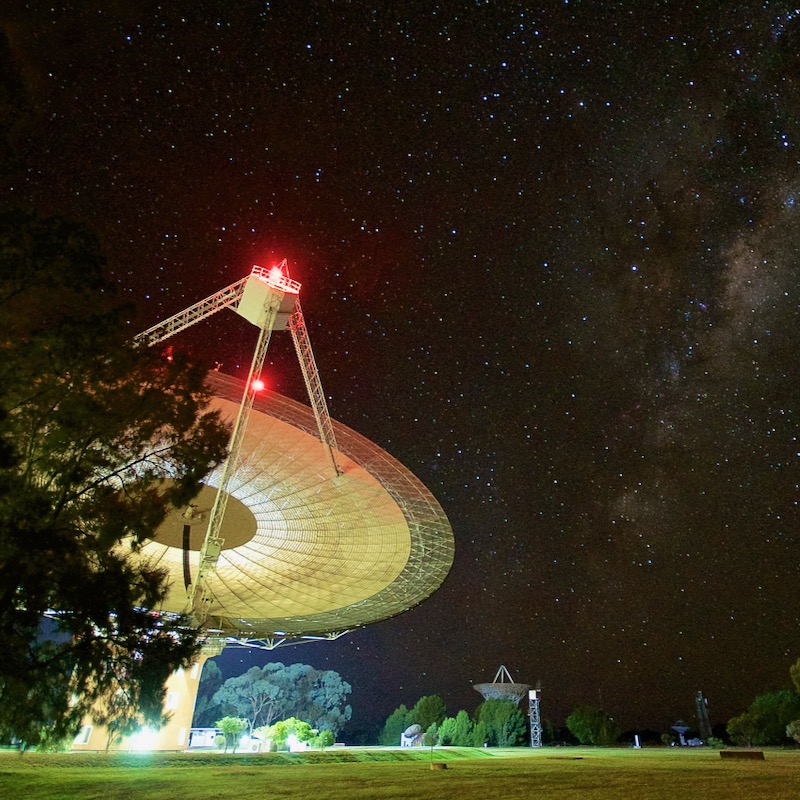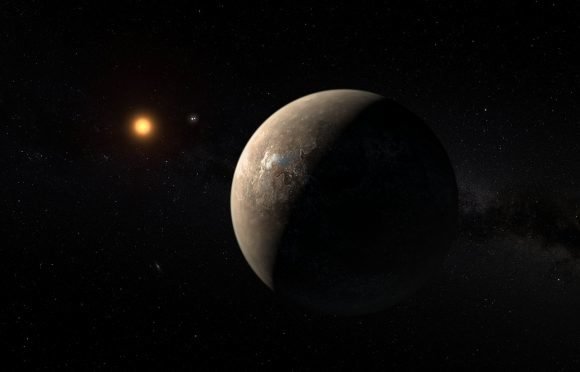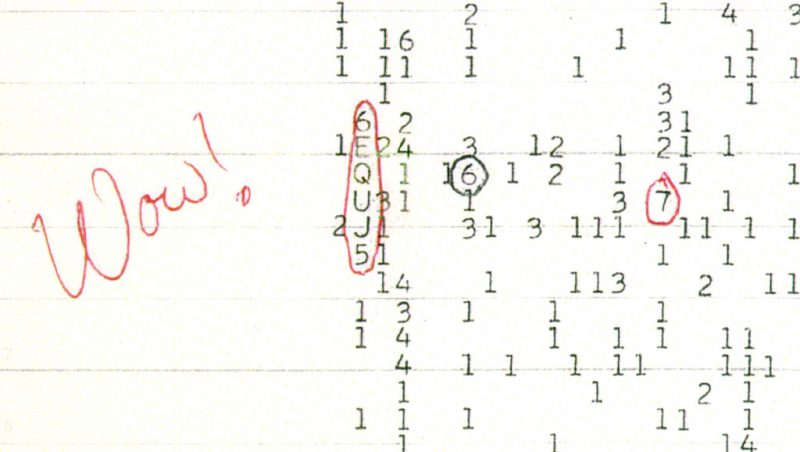There seems to be some incredible theorising -some bordering on fantasy- since this news item was leaked. Hopefully, this article by Paul Scott Anderson on Earthsky will make things clearer. See my notes at the end.
Was this mystery radio signal really from Proxima Centauri?

The Parkes radio telescope at Parkes Observatory in New South Wales, Australia. Astronomers using the telescope detected what appeared to be a radio signal coming from the direction of Proxima Centauri in April and May 2019. Image via Daniel John Reardon/ Wikimedia Commons.
Earlier this month, we told you about a possible source for the famous Wow! signal, first detected in 1977. Since its detection, the Wow! signal has been, in the opinion of many scientists engaged with the Search for Extraterrestrial Intelligence (SETI), the best candidate for an alien radio signal yet found. The 1977 Wow! signal was heard only once. It was never fully confirmed and remains unexplained to this day. But now, a new possible signal has been found, dubbed by some as Wow! signal 2020. And guess what? It appears to come from Proxima Centauri, the closest star to our sun.
EarthSky 2021 lunar calendars are available! Order now. Going fast!
The news comes from an apparent leak to The Guardian newspaper, which ran the story on December 17, 2020. What makes this detection unique and rather baffling is that the signal, narrowband and needle-sharp at 982.002 MHz, came from the direction of Proxima, which is so close to us, only about 4 light-years away. Astronomers with Breakthrough Listen first detected the signal on April 29, 2019, using the Parkes radio telescope at Parkes Observatory in Australia, but it was not actually found in the data until late October of this year. Two papers detailing the discovery and the analysis are reportedly due to come out sometime in early 2021.
The astronomers were not named in The Guardian article, so it seemed that the news was leaked by someone to the paper, hence the anonymity. By the next day, December 18, the story had been pretty much verified, although tempered with an abundance of caution. As mentioned in The Guardian:
The latest ‘signal’ is likely to have a mundane explanation too, but the direction of the narrow beam, around 980 MHz, and an apparent shift in its frequency said to be consistent with the movement of a planet have added to the tantalizing nature of the finding. Scientists are now preparing a paper on the beam, named BLC1, for Breakthrough Listen, the project to search for evidence of life in space, The Guardian understands.
As tends to happen, the story spread quickly, with commentary from various astronomers and other scientists about what it might be.

Artist’s concept of Proxima Centauri b, which is about 1.3 times the mass of Earth and orbits within the star’s habitable zone where liquid water could exist. Could the signal actually be from this planet? Maybe, but some features of the signal don’t seem to fit that scenario. Image via ESO/ M. Kornmesser/ Phys.org.
A follow-up article in Scientific American by Jonathan O’Callaghan and Lee Billings on December 18 has provided some additional details. Andrew Siemion at the University of California, Berkeley and director of the Berkeley SETI Research Center, is quoted as saying:
It has some particular properties that caused it to pass many of our checks, and we cannot yet explain it. We don’t know of any natural way to compress electromagnetic energy into a single bin in frequency. For the moment, the only source that we know of is technological.
There is also another good article at National Geographic by Nadia Drake.
The signal has the characteristics of being artificial, so then the question becomes “is it ours?” Many potential candidate signals are found, but the vast majority are soon found to be explained by terrestrial sources, satellites in space, errors, etc. As Jason Wright at Penn State University told Scientific American:
If you see such a signal and it’s not coming from the surface of Earth, you know you have detected extraterrestrial technology. Unfortunately, humans have launched a lot of extraterrestrial technology.
Sofia Sheikh at Penn State University, who headed the subsequent analysis for Breakthrough Listen and is the lead author on the upcoming paper, told National Geographic:
Only human technology seems to produce signals like that. Our WiFi, our cell towers, our GPS, our satellite radio, all of this looks exactly like the signals that we’re searching for, which makes it very hard to tell if something is from space or from human-generated technology.
A candidate signal must go through a series of screening filters before it can be seriously treated as a true potentially alien signal. This one has, so far, according to Sheikh:
It’s the most exciting signal that we’ve found in the Breakthrough Listen project, because we haven’t had a signal jump through this many of our filters before.

The famous “Wow! signal” detected by the Big Ear radio telescope at Ohio State University on August 15, 1977. Image via Big Ear Radio Observatory/ North American AstroPhysical Observatory (NAAPO)/ Wikipedia.
The candidate signal is now being referred to as Breakthrough Listen Candidate 1, or BLC1.
The detection was made as part of an overall study of Proxima Centauri by Breakthrough Listen. It was first noticed in the data by intern Shane Smith in late October this year as the data from 2019 was being re-analyzed, which is why no alert was sent out to other observatories back in 2019, as some people have questioned (that being normal SETI protocol). The signal was very narrow, 982.002 MHz to be exact. It was seen in five of the 30-minute long observations by the Parkes telescope, over a 30-hour period.
Given past history, it is most likely that a terrestrial human-made cause will be found, but the scientists involved are continuing to study it with much interest, and so far, they haven’t been able to identify the culprit.
Another point to note is that the signal apparently came from the direction of Proxima Centauri, but it’s not a slam-dunk that the star really is the source. It could also have been a source within the 16-arcminute (1/60 of a degree) beamwidth of the telescope that happened to be near Proxima Centauri in the sky from our vantage point. It also appears to a simple signal, with no modulation, just a single tone. As Siemion said:
BLC1 is, for all intents and purposes, just a tone, just one note. It has absolutely no additional features that we can discern at this point.
The signal does drift, as might be expected for a signal from an orbiting planet, but it is in the opposite direction of what would normally be expected. Sheikh said:
We would expect the signal to be going down in frequency like a trombone. What we see instead is like a slide whistle, the frequency goes up.
What all of this means exactly isn’t clear yet. Wright has made some interesting observations on Twitter, however:
So far, the signal hasn’t been seen again, just like with the Wow! signal in 1977. Another detection would help scientists determine just where it actually came from. As noted by Wright above, it’s possible that the signal didn’t come from Proxima Centauri at all, but rather another source that happened to be close to the star in the sky at the time, within the beamwidth of the telescope. The fact that it “reappeared” five times during the 30-minute observation windows, over a period of three hours, is interesting. That means when the telescope was briefly pointed away from the star, the signal disappeared, but came back when the telescope was looking at the star again, five times in all. That’s a seemingly good indication the signal did come from space, but more work is needed to see if it could have been an earthly satellite.
Proxima Centauri is the closest star to the sun, only 4.2 light-years away, and is a red dwarf with at least two known planets. One of those planets, Proxima Centauri b, is just a bit larger than Earth, and orbits within the habitable zone of the star, the region where temperatures could allow liquid water to exist. The other planet, Proxima Centauri c, is about seven times more massive than our Earth.
But little else is known about these worlds so far, and the star itself is very volatile, emitting powerful flares of ionizing radiation. Proxima Centauri b in particular is subject to this radiation, even though it is in the habitable zone, so whether it is actually potentially habitable is far from certain at this point.

Sofia Sheikh at Penn State University, who headed the analysis for Breakthrough Listen and is the lead author on the upcoming paper. Image via Penn State University.
Also, what are the odds that another technological civilization would be located at the very nearest star to us? With so many billions of stars in our galaxy? The odds seem very much against it, but all we can do is follow the data and evidence as we learn it. The signal seemingly must either be from Proxima Centauri, another unrelated source within the beamwidth of the telescope, or from terrestrial interference. Past experience suggests the third option, but there is still a lot more analysis to be done.
Stay tuned for updates on this intriguing discovery. If nothing else, BLC1 has given us a fascinating new mystery to try and solve!
-------------------------------------------------fin------------------------------------------
Some Ufologists and "other types" are stating that the signal came FROM Proxima Centauri but it did not. It came from a wide arc of space around the star and that is a vast amount of space. I'll give you a practical example.
While I was in Junior School, coming up to 11 years old, I was in the playground and decided to get my own back on Chris who had outrageously snow-balled me earlier. So, there he was directly ahead of me. I made a snowball and threw it....it passed Chris and hit a teacher who looked around with a less than happy face. Teacher knew which direction the snowball had come from but there were at least 7 other pupils -including Chris. Unless someone put their hand up and shouted "That was me!" (riiight) the teacher had no idea who threw it.
This BLC1 is the same thing. It came (seemingly) from the direction of Proxima Centauri which is the "Chris" in the respect. How far a saignal travelled and for how long is what the team needs to calculate if this is a genuine signal. I hope it is because that means a great deal. Unlikely that BLC1 is from any civilization that might be responsible for UFO incidents (logically, it is pointless signalling out into space and a specific (IF it was aimed at Earth -we may have just got in the way) target if you are already there unless the signal was being sent to a Lurker (see the new book it explains what Lurkers are).
We are dealing with cautious astronomers here who need facts before announcing anything and if it was not a signal we'll hear all the usual conspiracy and cover up crap for years. Some SETI astronomers need to be removed from their jobs -such as Mr Shostok who seems near to wetting his pants in fear at the possibility of intelligent life in space (I think he just wanted an easy job paying good money with free meal tickets).
EVERY possibility has to be ruled out until someone can say "It WAS a signal" -at which point the Shostoks can jump in to scream "No!" and get all the media attention they like (it means more money and free dinners).



No comments:
Post a Comment